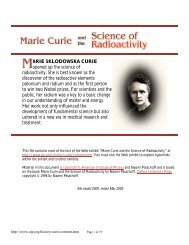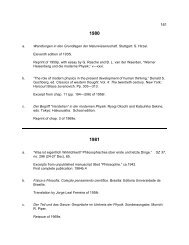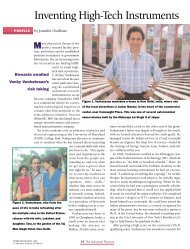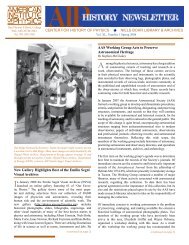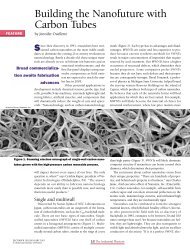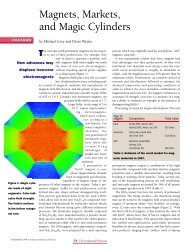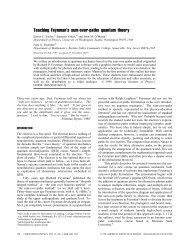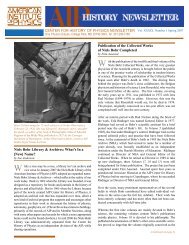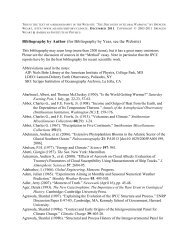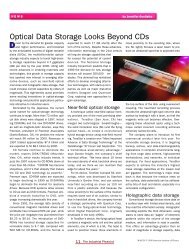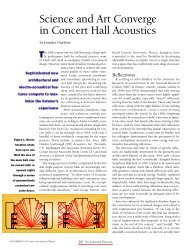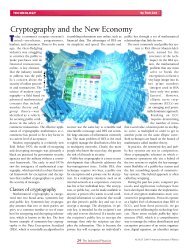AIPHISTORY NEWSLETTER - American Institute of Physics
AIPHISTORY NEWSLETTER - American Institute of Physics
AIPHISTORY NEWSLETTER - American Institute of Physics
Create successful ePaper yourself
Turn your PDF publications into a flip-book with our unique Google optimized e-Paper software.
Preservation <strong>of</strong> Archives at the U. S.<br />
Naval Observatory<br />
by Brenda G. Corbin<br />
T<br />
he majority <strong>of</strong> the early records <strong>of</strong> the U. S. Naval Observatory<br />
(USNO), mid 1800s to about 1930s, are currently in<br />
Record Group 78 at the National Archives and Records Administration<br />
(NARA). A smaller amount <strong>of</strong> USNO archives, up to<br />
1970, has also been placed in NARA. The remainder <strong>of</strong> the<br />
archives are still housed in the USNO Library. These archives<br />
range from the mid 1800s to the present.<br />
Much <strong>of</strong> the archival materials from the 1930s forward had for<br />
many years been kept in the various departmental <strong>of</strong>fices where<br />
the records originated. Meanwhile, as older staff retired, many<br />
feared that the history files in their <strong>of</strong>fices might not survive<br />
and turned these records over to the Library. These files also<br />
contained much non-historical material not belonging in the<br />
archives. A recent acquisition was the papers (about 25 boxes)<br />
<strong>of</strong> the former Scientific Director, Dr. K. Aa Strand (1907-2000).<br />
Steven J. Dick, former historian <strong>of</strong> the USNO, spent over 15<br />
years writing and researching the history <strong>of</strong> the USNO, Sky and<br />
Ocean Joined, the U. S. Naval Observatory 1830-2000 (Cambridge<br />
University Press, 2003). Dr. Dick organized the archives<br />
on hand and used these plus other sources to write this complete<br />
history. Once the history was finished, the historian’s<br />
position was abolished due to budget cuts, but material kept<br />
arriving in unsorted boxes.<br />
At this point, the USNO History Committee was reactivated<br />
and the Librarian named Chair. The Committee decided to transfer<br />
all archival material to NARA. Much work would be involved<br />
and each Committee member already had a full-time<br />
position at USNO. One retiring staff member agreed to pack his<br />
department’s archives (ca. 1950s-early 1990s) into the boxes<br />
required by NARA. Materials from file cabinets were placed<br />
into 97 boxes and he wrote very brief notes about the contents<br />
<strong>of</strong> each box. However, no time has been available as yet to enter<br />
this contents information onto the required forms SF-135 which<br />
must be placed in each box before transfer to NARA. How could<br />
the rest <strong>of</strong> this transfer be accomplished? Several solutions<br />
were suggested, some unusual.<br />
One proposal was an Eagle Scout project, in which the Scouts<br />
would move materials from file cabinets and other boxes into<br />
the approved NARA boxes and gather the boxes (more than<br />
300) into a central location for pick-up by NARA. There would<br />
be no sorting <strong>of</strong> materials, only direct transfer into NARA boxes.<br />
However, the Scout Council did not approve this project, preferring<br />
a more traditional Eagle project.<br />
A smaller work project took place this summer when Science<br />
and Engineering Apprentice Program (SEAP) students assigned<br />
to the USNO spent a seminar period (1.5 hours) transferring<br />
6 ● History Newsletter Fall 2005<br />
materials from older boxes to the NARA boxes. Although no<br />
weeding or sorting <strong>of</strong> these materials could be done without<br />
much more training, the contents <strong>of</strong> approximately 25 boxes<br />
were moved into the NARA boxes. Even this very short project<br />
probably gave these students some appreciation for the archival<br />
materials.<br />
The Librarian, who retired on October 1, 2005, proposed a parttime<br />
position where she would work only on the archives project<br />
until the files are ready to be transferred. Due to budget cuts<br />
within the Department <strong>of</strong> Defense, this position has not yet been<br />
approved. With most <strong>of</strong> the older USNO staff members retiring, it<br />
is a real concern that corporate memory <strong>of</strong> these archives will be<br />
lost. Although the members <strong>of</strong> the History Committee are aware<br />
<strong>of</strong> the problem and concerned, finding time and personnel to<br />
carry out this archives transfer project will be very difficult.<br />
The problem facing the USNO is not unusual. As institutions<br />
face budget cuts, historians and archivists are not high on the<br />
list <strong>of</strong> required employees: scientific positions must take precedence.<br />
We can only hope that a solution can be found before<br />
someone later decides these materials are useless and relegates<br />
them to a dumpster.<br />
NSF Funding for Science Studies<br />
Reorganized<br />
T<br />
he National Science Foundation (NSF) Science<br />
and Technology Studies (STS) Program and the<br />
NSF Societal Dimensions <strong>of</strong> Engineering, Science, and<br />
Technology (SDEST) Program no longer exist under<br />
those titles. The new, consolidated program title is Science<br />
and Society (S&S), which can be found on the NSF<br />
Website at www.nsf.gov/funding. In the text box, type<br />
“Science and Society” (without the quotes) and then<br />
select “--SBE/SES: Social & Economic Science” from the<br />
drop-down menu. Then click on the “Search” button.<br />
The new program includes the following components:<br />
Ethics and Values in Science, Engineering, and Technology<br />
(EVS); History and Philosophy <strong>of</strong> Science, Engineering,<br />
and Technology (HPS); Social Studies <strong>of</strong><br />
Science, Engineering, and Technology (SSS); and Studies<br />
<strong>of</strong> Policy, Science, Engineering, and Technology<br />
(SPS). The annual target dates for proposals are February<br />
1 and August 1.<br />
For information on EVS and SPS, contact Priscilla Regan<br />
at pregan@nsf.gov.<br />
For information on HPS and SSS, contact Ron Rainger at<br />
rrainger@nsf.gov.<br />
For information on dissertation research support, contact<br />
John Perhonis at jperhoni@nsf.gov.



